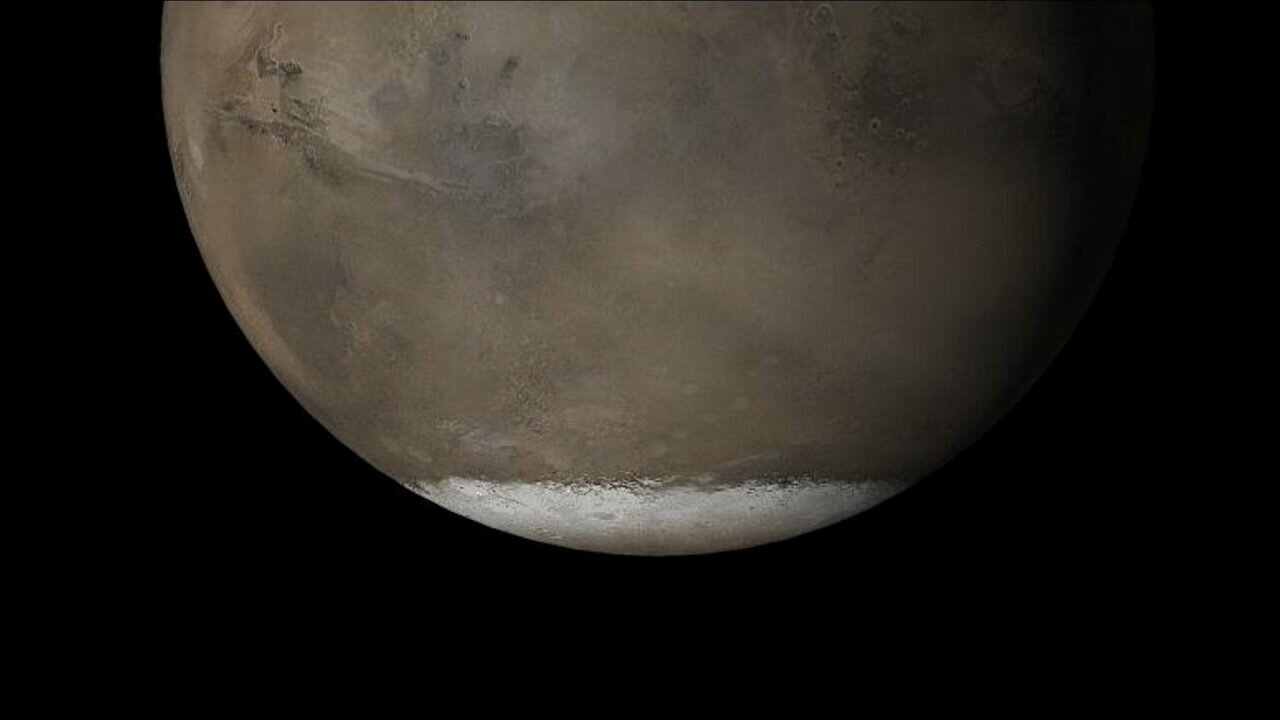Last updated October 25, 2018 at 2:39 pm
It might be the best chance we’ve had to discover life on another planet.

For decades scientists have argued whether there is liquid water on Mars. But we may have just received a definitive answer with the discovery of a giant lake under the surface near the South Pole.
Some scientists have described the finding, published in Science, as the most exciting result in planetary science in recent years.
Using the Mars Express satellite to probe beneath the surface of the red planet, the researchers spotted the lake, some 20 km across, deep under the polar ice cap.
However, hopes that it could be a source of water for future explorers are dashed, it’s likely extremely salty and remains out of reach at 1.5 km below the surface.
It could, however, harbour life of its own.
First confirmed liquid water on Mars
There are signs that Mars used to have water on its surface – dry river valleys and lakes are found across the planet. However, as long as humans have been looking, the water has remained elusive.
When the Phoenix lander touched down on the planet in 2008, water droplets were seen condensing on its surface. There have also been hints that water could have been running down slopes during the Martian summer, although they are suspected to have been sand flows rather than water.
Despite these hints and years of searching, a stable water source had never been found until now.
For three years researchers from Italy’s Istituto di Radioastronomia of INAF and collaborators surveyed the Planum Australe region in the southern ice cap of Mars using the Mars Advanced Radar for Subsurface and Ionosphere Sounding (MARSIS) instrument on the Mars Express spacecraft. MARSIS works by sending a radar pulse that penetrates the surface and ice caps of the planet, with reflections returned to the spacecraft revealing what’s underneath.

Artistic impression of the Mars Express spacecraft probing the southern hemisphere of Mars,
superimposed on a radar cross section of the southern polar layered deposits. The uppermost white line is the surface radar echo, while the light blue spots along the basal radar echo highlight areas of very high reflectivity, interpreted as being
caused by the presence of water. Credit: ESA, INAF. Graphic rendering by Davide Coero Borga–Media INAF
In their data they discovered a very sharp change in the radar signal about 1.5 km below the surface of the ice, and about 20 km wide. The signals received looked very similar to signals seen when mapping lakes of liquid water found beneath the Antarctic and Greenland ice sheets on Earth. After eliminating other potential reasons, they concluded that the signal was indeed a subglacial lake on Mars.
“We estimate that it has to be, as a minimum, of the order of 1 metre (deep),” said lead researcher Roberto Orosei.

Color mosaic of a portion of Planum Australe, in which the study area is highlighted using a THEMIS IR image mosaic. Subsurface echo power is color coded and deep blue corresponds to the strongest reflections, which are interpreted as being caused by the presence of water. Credit: USGS Astrogeology Science Center, Arizona State University, INAF
“(That depth) really qualifies this as a body of water, a lake, not really like some kind of melt water filling some space between rock and ice.”
It’s almost certain that the temperature of the lake is well below the freezing point of pure water. However, the results strongly indicate that magnesium, calcium, and sodium – known to be present in Martian rocks – are probably dissolved in the water to form a brine, which could lower its melting temperature to as low as -60°C.
Between the salty brine and pressure from the overlying ice the water’s melting point would be lowered enough to allow the lake to remain liquid, similar to what happens on Earth.
“This is a stunning result,” said Australian astronomer Alan Duffy, who was not involved in the research.
“The underground water might exist as a lake trapped beneath rock layers or mixed in with Martian soil to create a salty sludge, but either way at 20 kilometres across there is a lot of it.”
“There’s nothing special about this location other than the MARSIS radar on the Mars Express spacecraft is most sensitive to that region, meaning there are likely similar water deposits below the ground all across Mars,” said Duffy.
Could this mean life on Mars?
The thought of more of these liquid lakes, and what they could contain, has researchers incredibly excited.
On Earth, where we find water we also find life. Indeed, much of the search for life on other planets is centred around locating liquid water.
“There is the fascinating possibility that microbial life could survive and flourish in sub-glacial Martian waters,” said Brendan Burns, an astrobiologist from the University of New South Wales.
In ice-locked lakes deep within Antarctica, scientists have observed basic lifeforms living in conditions that are likely very similar to those in the Martian lake. These bacteria have evolved to survive in the freezing temperatures without sunlight, raising the possibility that similar lifeforms could have evolved on Mars.
“Whether similar scenarios are occurring on Mars remain to be experimentally established, but this finding of potential liquid water beneath the surface of Mars opens up fascinating areas of space exploration,” Burns said.
While it’s not known if life is even capable of surviving in the highly salty, possibly sludgy water, researchers are still suggesting it’s our best chance at the moment of finding life on another planet.
“If life ever existed on Mars it is likely still to exist,” remarked Malcolm Walter, an Emeritus Professor of Astrobiology University of New South Wales.
We could have just found its home.




























































































































































































































































